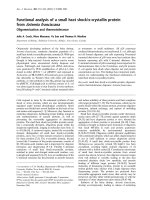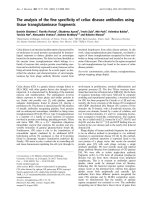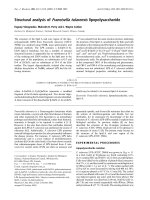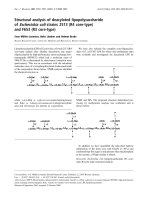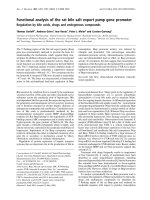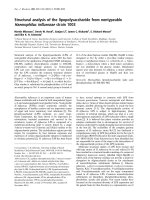Báo cáo y học: " Transcriptome analysis of murine thymocytes reveals age-associated changes in thymic gene expression"
Bạn đang xem bản rút gọn của tài liệu. Xem và tải ngay bản đầy đủ của tài liệu tại đây (2.42 MB, 14 trang )
Int. J. Med. Sci. 2009, 6
51
I
I
n
n
t
t
e
e
r
r
n
n
a
a
t
t
i
i
o
o
n
n
a
a
l
l
J
J
o
o
u
u
r
r
n
n
a
a
l
l
o
o
f
f
M
M
e
e
d
d
i
i
c
c
a
a
l
l
S
S
c
c
i
i
e
e
n
n
c
c
e
e
s
s
2009; 6(1):51-64
© Ivyspring International Publisher. All rights reserved
Research Paper
Transcriptome analysis of murine thymocytes reveals age-associated
changes in thymic gene expression
Ana Lustig
1
, Arnell Carter
1
, Dorothy Bertak
1
, Divya Enika
1
, Bolormaa Vandanmagsar
1
, William Wood
2
,
Kevin G. Becker
2
, Ashani T. Weeraratna
1
and Dennis D. Taub
1
1. Laboratory of Immunology, National Institute on Aging-Intramural Research Program, National Institutes of Health,
Baltimore, MD. 21224, USA
2. The Research Resources Branch, National Institute on Aging-Intramural Research Program, National Institutes of
Health, Baltimore, MD. 21224, USA
Correspondence to: Dennis D. Taub, Ph.D., Laboratory of Immunology, National Institute on Aging-Intramural Research
Program, National Institutes of Health, 5600 Nathan Shock Drive, Baltimore, MD. 21224, Phone: (410) 558-8159, Fax: (410)
558-8284; Email:
Received: 2009.01.28; Accepted: 2009.02.08; Published: 2009.02.09
Abstract
The decline in adaptive immunity, naïve T-cell output and a contraction in the peripheral T
cell receptor (TCR) repertoire with age are largely attributable to thymic involution and the
loss of critical cytokines and hormones within the thymic microenvironment. To assess the
molecular changes associated with this loss of thymic function, we used cDNA microarray
analyses to examine the transcriptomes
of thymocytes from mice of various ages ranging
from very young (1 month) to very old (24 months). Genes associated with various bio-
logical and molecular processes including oxidative phosphorylation, T- and B- cell receptor
signaling and antigen presentation were observed to significantly change with thymocyte age.
These include several immunoglobulin chains, chemokine and ribosomal proteins, annexin
A2, vav 1 and several S100 signaling proteins. The increased expression of immunoglobulin
genes in aged thymocytes could be attributed to the thymic B cells which were found to be
actively producing IgG and IgM antibodies. Upon further examination, we found that purified
thymic T cells derived from aged but not young thymi also exhibited IgM on their cell surface
suggesting the possible presence of auto-antibodies on the surface thymocytes with ad-
vancing age. These studies provide valuable insight into the cellular and molecular mecha-
nisms associated with thymic aging.
Key words: thymus, involution, aging, microarray, AGEMAP, thymocytes, caloric restriction
Introduction
The aging immune system is often characterized
by a general decline in the ability to resist infection
and an increase in autoimmune complications such as
type 2 diabetes, inflammation, and cancer [1-9]. One
of the underlying causes of the reduced effectiveness
of the immune system with age is the involution of the
thymus. As the thymus involutes, there is a resulting
decrease in naïve T cell output, and consequently
memory T cells occupy a larger portion of the pe-
ripheral T cell pool [10-16]. However, this loss in
thymic output with age does not result in any sig-
nificant change in the total number of peripheral T
cells. The maintenance of peripheral T-cell numbers
appears to be regulated via a thymus-independent
homeostatic process involving expansion of mature
peripheral T cells which results in a much more lim-
ited T-cell receptor (TCR) repertoire with age. While
the precise mechanism(s) facilitating thymic involu-
Int. J. Med. Sci. 2009, 6
52
tion has yet to be determined, it appears that this
thymic loss is an active process involving a variety of
factors including the loss and apoptosis of the thy-
mocytes and supportive cell populations within the
microenvironment, alterations in the appropriate
signals from supporting stromal and epithelial cells,
diminished progenitor cell recruitment and expansion
and a decrease in steroid signaling essential for thy-
mocyte development [17-25]. Other factors which are
yet to be identified may also be involved. Given that
the loss in thymic function is one of the earliest and
most consistent steps in the progression to immune
dysfunction, thymic involution seems to be a most
promising target for therapeutic intervention to re-
verse thymic atrophy and restore thymic function.
Given that the aged thymus consists of large ar-
eas of fat and connective tissue [26, 27], we have fo-
cused our efforts on performed DNA array analysis
specifically on isolated thymocyte populations in or-
der to obtain a clearer picture of which genes or gene
families may demonstrate altered expression levels
with age. Our results demonstrate that genes associ-
ated with various biological and molecular processes
including oxidative phosphorylation, T- and B- cell
receptor signaling and antigen presentation were ob-
served to significantly change with thymocyte age.
Interesting, the expression of several immunoglobulin
chains were also found to be significantly increased in
aged thymocytes. Understanding the changes in gene
expression in thymocytes with age may hold the key
in determining thymocyte fate and decreased thymic
output with age.
Materials and Methods
Mice. Specific pathogen-free C57BL/6 mice of
various ages were purchased through the Office of
Biological Resources and Resource Development of
the National Institute on Aging (Bethesda, MD). All
mice were maintained in an AAALAC-certified bar-
rier facility and were acclimated for 2 weeks prior to
use. All mice were fed autoclaved food and water ad
libitum. All mice with evidence of disease (e.g.,
enlarged spleen, gross tumors) were not utilized in
these studies.
Thymocyte isolation. Freshly-extracted thymi
from mice of various ages were dissociated in RPMI
using a syringe and forceps. Cell clumps were broken
up with repeated pipetting and then poured through
70μm nylon mesh cell strainers (BD Falcon, Bedford,
MA) to remove connective tissue and any remaining
clumps. The cells were washed once to remove fat
cells, which will float to the top rather than pelleting
at the bottom with the thymocytes. The red blood cells
then were lysed with ammonium chloride buffer. The
remaining thymocyte population, which reflects the
actual interactive environment of the thymus, was
counted, washed twice in RPMI followed by PBS. The
cell pellets were either used directly in the Qiagen
RNEasy mini kits for RNA preparation or lysed in
RIPA buffer containing protease and phosphatase
inhibitors (Sigma, St Louis, MO) to use in Western
blot analysis, or resuspended in the appropriate
buffer for whatever assay was used following cell
preparation.
In certain experiments, thymocytes were mag-
netically labeled using the Pan T cell isolation kit, then
passed through LD magnetic cell separation columns
(Miltenyi Biotec, Auburn, CA), to separate them into T
cell and non-T cell subsets. RNA was then isolated
from these cell subsets using the Qiagen RNEasy Mini
Kit as described below, and used for real-time
RT-PCR as described above.
RNA extraction and array analysis. For each array
sample, the RNA was prepared from the purified
thymocytes. The thymocytes were processed by using
the RNEasy Mini Kit (Qiagen, Valencia, CA). Quality
and quantity of total RNA samples was assessed us-
ing an Agilent 2100 Bioanalyzer (Agilent Technolo-
gies, Palo Alto, CA). This total RNA was used to gen-
erate fluorescent cRNA for use with Agilent’s oli-
gonucleotide microarrays. The RNA was amplified
and labeled using the Agilent Low RNA Input Fluo-
rescent Linear Amplification Kit following manufac-
tures protocols. In Short: Between 0.5μg to 2μg of total
RNA was used to generate first and second strands of
cDNA containing a T7 RNA polymerase promoter.
Then cRNA was synthesized using T7 RNA poly-
merase which simultaneously incorporates cyanine 3-
or cyanine 5- labeled CTP (Perkin Elmer, Wellesley,
MA). Qiagen RNeasy columns (Qiagen Valencia, CA)
were used to purify the labeled cRNA and the final
concentration was assessed using a Nanodrop
ND-1000 spectrophotometer (Nanodrop Technolo-
gies, Wilmington, DE). 750 ng of Cy3-labeled cRNA
and 750 ng of Cy5-labeled control sample were com-
bined with spiked in control probes specific for targets
on the arrays and hybridized over night at 60
0
C to
Agilent Mouse Whole Genome 44K Oligo Microarrays
(Agilent Technologies, Palo Alto, CA). The arrays
were washed at room temperature 6X SSC with
0.005% Triton X-102 for 10 minutes and 0.01x SSC
with 0.005% Triton X-102 at 4
0
C for 5 minutes. The
slides were then dried in a nitrogen stream and
scanned at 10 micron resolution using an Agilent Mi-
croarray scanner G2565BA. Data was extracted using
Agilent Feature Extractor Software (v7.1).
Statistical data analysis. All data was processed a
Z score statistical analysis method developed at NIA
Int. J. Med. Sci. 2009, 6
53
[28]. In order to be selected for the final gene list, the
expression value of a particular gene had to be at least
1.5 times different from the Z score of the control.
Differences were considered statistically significant
only if they had a p value less than 0.01.
Gene expression profiles. The selected gene lists
were uploaded along with their Z scores to the Mi-
croarray Data Analysis website of the National Hu-
man Genome Research Institute
( Using dis-
tance-based gene selection, gene expression profiles
were created in order to visualize differences between
age, gender and diet.
Real-time PCR. Array results were verified by
semi-quantitative RT-PCR. One-half to one micro-
gram of RNA from thymocyte samples were used to
make cDNA with the iScript cDNA synthesis kit (Bio-
Rad, Hercules, CA). One microliter of each cDNA
sample was then used to measure quantity using the
SYBR Green PCR master mix (Applied Biosystems)
and reactions were run on the 7500 fast or 7300 PCR
system (Applied Biosystems). The results were nor-
malized to 18S using the QuantumRNA universal 18S
(Ambion, Austin, TX) and were also used to deter-
mine relative quantities. The primers are shown in
Table 4.
Western blot analysis. Equal amounts of protein
from thymocytes were run on 10% tris-glycine gels
and transferred to PVDF membranes (Invitrogen,
Carlsbad, CA) on the Novex gel-blot system (Invitro-
gen, Carlsbad, CA). The nitrocellulose filters were
then probed using HRP-conjugated specific antibod-
ies to the immunoglobulin heavy chain M (IgM) and
IgG obtained from Abcam (Cambridge, MA). The
antibody to beta-actin was from Sigma-Aldrich (St.
Louis, MO). The HRP-conjugated secondary antibody
for the beta-actin was from Amersham (Piscataway,
NJ). Bands were visualized using the ECL Plus west-
ern blotting detection reagents (Amersham) and CL-X
Posure film from Pierce (Rockford, IL).
Flow cytometry. Cell suspensions were washed in
HBSS with 0.1% BSA and 0.1% sodium azide
(Sigma-Aldrich, St. Louis, MO). Antibody against Fc
receptors was used to block non-specific binding (BD
Biosciences, San Jose, CA). Cells were stained ex-
tracellularly for B220 (BD) ten minutes on ice and ei-
ther simultaneously stained for extracellular IgM
(Caltag, Carlsbad, CA), or subsequently stained for
intracellular IgM. For intracellular staining, the cells
were fixed in PBS containing 2% paraformaldehyde
(Sigma-Aldrich) and washed twice in PBS with 0.03%
saponin to permeabilize the cell membranes.
Anti-IgM was added for 30 minutes at 4 degrees, and
then the cells were washed twice in PBS with sodium
azide. The stained cells were then run on a FACScan
flow cytometer (BD) and the data analyzed using Cell
Quest software (BD).
Results
Gene expression changes were identified by
comparing gene expression profiles across the indi-
cated age groups to the gene expression profiles of the
1 month age group (Figure 1). While the numbers of
genes with decreased expression were fairly consis-
tent throughout the three older ages, the number of
genes with increased expression peaked in the
16-month age group. Table 1 lists the canonical cellu-
lar pathways affected by changes in gene expression
levels with thymocytes age. This list was generated by
uploading the list of genes with the most significant
changes to the Ingenuity Analysis website
( Table 1A lists all
pathways affected at any age group. As would be
expected, these included pathways involved in lym-
phocyte receptor signaling and antigen presentation.
Genes involved in oxidative phosphorylation were
the most numerous regardless of age group. Pathways
involving purine metabolism, PI3/Akt signaling, and
ubiquinone synthesis are the ones most affected dur-
ing aging (Table 1B). All of these pathways are in-
volved in cell survival [29-33], and deficiencies in the
ubiquinone pathway have already been linked to in-
creased longevity in mice [34].
Figure 1. Number of genes at each age group with expression
levels higher or lower than levels exhibited by the 1 month age
group. The bars labeled total show the total number of all
genes changed at all ages. Red bars depict the number of
genes which increased expression levels and green bars
depict the number of genes which decreased expression
levels.
Int. J. Med. Sci. 2009, 6
54
Table 1. Canonical pathways containing thymocyte genes which
changed expression levels with age. These pathways were
identified by the ingenuity data analysis program
(www.ingenuity.com) using our uploaded data.
ALL CHANGES AT ALL AGES
CANONICAL PATHWAYS NUMBER of GENES p VALUE
Oxidative Phosphorylation 18 0.001
T Cell Receptor Signaling 15 1.2 x 10
-5
Antigen Presentation 14 4.7 x 10
-8
B Cell Receptor Signaling 14 0.007
Purine Metabolism 14 NS
G Protein Coupled Receptor 13 0.001
Integrin Signaling 13 0.17
Erk/MAPK Signaling 11 0.10
PI3/Akt Signaling 10 0.03
Apoptosis Signaling 9 0.017
CHANGES at 24 MONTHS
CANONICAL PATHWAYS NUMBER of GENES p VALUE
Oxidative Phosphorylation 11 6.8 x 10
-4
Purine Metabolism 9 2.0 x 10
-1
Antigen Presentation 8 7.6 x 10
-6
TCR Signaling 6 9.7 x 10
-3
PI3/Akt Signaling 6 2.4 x 10
-2
Ubiquinone Synthesis 4 3.1 x 10
-2
Pathway analysis (www.ingenuity.com) identi-
fied signaling pathways and gene families that were
affected in aging thymocytes. Table 2A lists all af-
fected functions regardless of age and Table 2B lists
the functions most affected at the oldest age group
and highlighted groups of genes involved in immune
response, development and disease. In the oldest age
group, the functional category including the most
genes was cell-to-cell signaling and interaction, which
could play a key role in thymocyte survival or death
associated with age. Many genes associated with
cancer are also affected in aging thymocytes. Given
the increased incidence of cancer with age [7, 35, 36]
( />tion/ConferencesAndMeetings/WorkshopReport/Fi
gure1.htm), this may be a valuable group of genes
warranting further scrutiny.
In order to obtain an expression profile of the
genes which changed the most with age, we uploaded
all of our array data into the array analysis program of
the NHGRI (). Table 3
lists the top genes that were up- or down-regulated
with age. A. A complete list of all genes that changed
with age is available on request. Most of the genes
with the greatest increase were immunoglobu-
lin-associated genes. This was a very interesting
finding, given that the number of immunoglobu-
lin-producing cells within the thymus is actually quite
limited. In order to identify genes that can discrimi-
nate among aging versus young thymocytes, we sub-
jected our array data to distance-based analysis. Fig-
ure 2 shows the top 100 genes with significant differ-
ences in expression levels at all ages. The most notable
aspect of the profile is the fact that all 100 genes ex-
hibiting the greatest differences with age actually in-
creased in expression. In light of these results, we fo-
cused our attention on genes demonstrating increased
transcription, more specifically several of the immu-
noglobulin-associated genes found to be up-regulated
in their expression in thymocytes with age. As shown
in Table 4, real time RT-PCR confirmed the increased
levels of many of these genes identified in the array
analysis. Moreover, Western blot analysis of thymo-
cyte lysates also confirmed that IgM increases with
age (Figure 3). Flow cytometry analysis shows that
there is also a modest age-associated increase in the
percentage of IgM
+
/B220
+
B cells within the thymus
and that this increase in IgM is both extra- and in-
tra-cellular (Figure 4).
Table 2. Functional categories containing thymocyte genes
which changed expression levels with age. These groups were
identified by the ingenuity data analysis program
(www.ingenuity.com) using our uploaded data.
ALL CHANGES AT ALL AGES
GENE FUNCTION NUMBER of
GENES
p VALUE
Hematological System Development
and Function
48 3.82 x 10
-4
Immune and Lymphatic System
Development and Function
45 3.82 x 10
-4
Cell-to-Cell Signaling and Interaction 42 8.00 x 10
-3
Cancer 32 3.44 x 10
-4
Immune Response 31 2.40 x 10
-2
Small Molecule Biochemistry 22 9.52 x 10
-3
DNA Replication, Recombination
and Repair
20 2.48 x 10
-2
CHANGES at 24 MONTHS
GENE FUNCTION NUMBER of
GENES
p VALUE
Cell-to-Cell Signaling and Interaction 22 0.016
Hematological System Development
and Function
18 0.012
Immune and Lymphatic System
Development and Function
17 0.010
Small Molecule Biochemistry 16 0.005
Cellular Assembly and Organization 16 0.023
Cancer 15 0.010
Cellular Function and Maintenance 14 0.001
Cell Cycle 13 9.52 x 10
-3
Immunological Disease 12 0.002
Int. J. Med. Sci. 2009, 6
55
Figure 2. Expression
profile of the most sig-
nificantly changed genes
with age. This profile
was generated in the
NHGRI website
(
h.gov), using dis-
tance-based analysis of
total data and showing
the top 100 changed
genes. Red represents
up-regulation of gene
expression, and green
represents down regu-
lation of gene expres-
sion.


